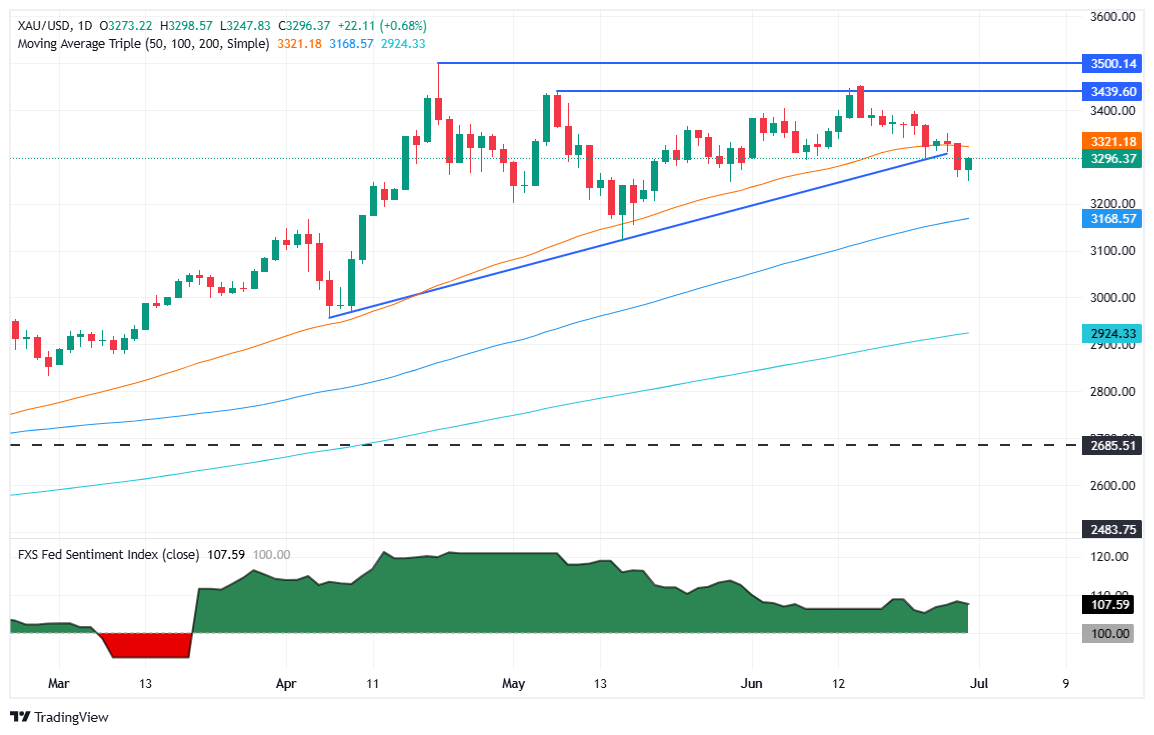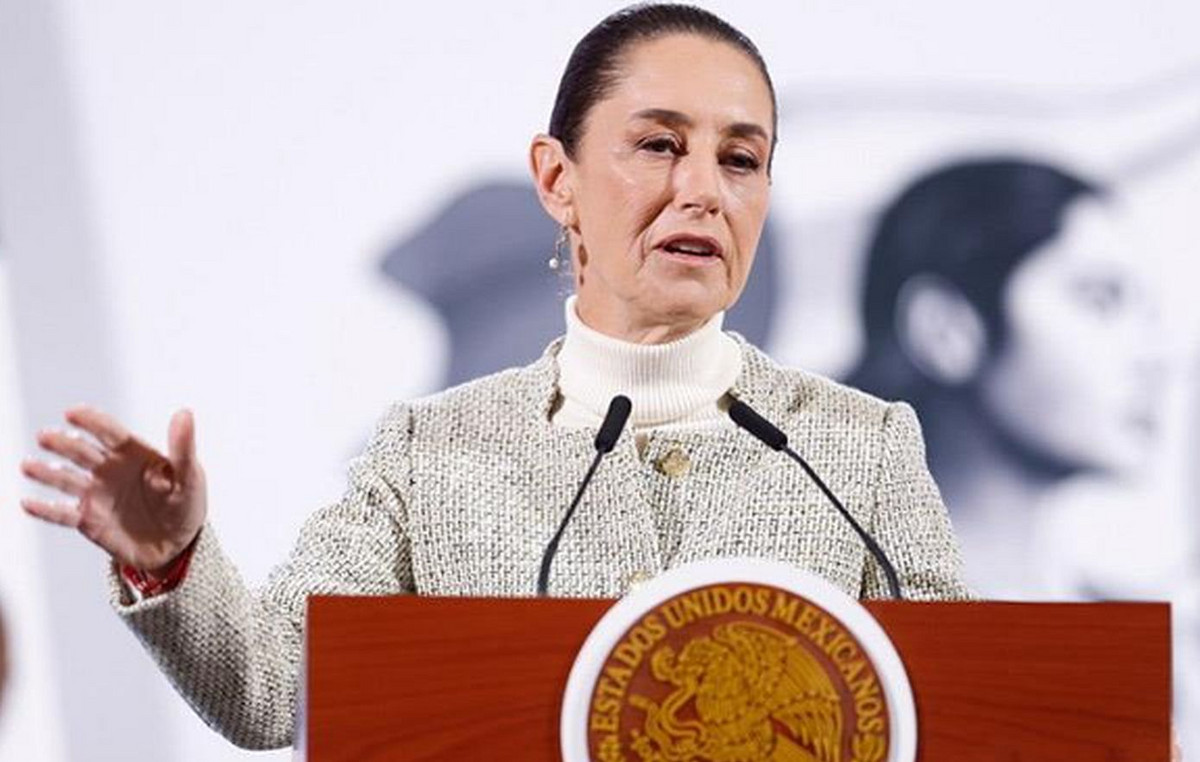- Gold bounces from $ 3,246 while the US dollar approaches the minimum of February 2022 amid the uncertainty about Fed leadership.
- Citi sees the gold consolidating between $ 3,100 and $ 3,500 in the third quarter; The calm in the East limits the flows to shelter.
- The ingot rose but remained limited by the calm geopolitical risks.
- Traders prepare for the ISM, ADP, unemployment requests and NFP in a week shortened by vacations.
The price of gold (Xau) advances modestly on Monday, rising 0.58%, while the US dollar (USD) extended its losses before an economic calendar occupied in the United States (USA). Speculations that US President Donald Trump could choose the new president of the Federal Reserve (FED) for September or October harmed the dollar, which is quoted near the minimum of February 2022.
The XAU/USD pair quotes at $ 3,292 after bouncing from minimum daily $ 3,246, prepared to close June with profits of more than 0.18%. The decrease in geopolitical tensions in the Middle East, together with the probable announcement of commercial agreements, limited the advance of the ingot. Meanwhile, Citi revealed that gold could consolidate between $ 3,100 and $ 3,500 on the third quarter.
The US Treasury Secretary, Scott Besent, said he is confident that the “One Big Beautiful Bill” will advance in the next few hours. The legislation, which passed by little in the Senate during the weekend, proposes a complete review of the fiscal code, including broad deductions financed by clippings to Medicaid and green energy programs.
This weekly week, before the US Independence Day on July 4, it will have data from the ISM manufacturing PMI, ADP employment figures, initial unemployment applications and the report of non -agricultural payrolls for June.
What moves the market today: the price of gold rises while US yields and the US dollar falls
- The Xau/USD is driven by the fall in the yields of the US Treasury bonds, with the 10 -year Treasury Bonus yield by 4,242%, a decrease of three basic points. The real US yields, which are calculated by subtracting inflation expectations of nominal performance, also decrease three basic points to 1,952%.
- Regarding trade, the US and China are solving previous problems related to the Agreement of Rare Land Minerals, and Canada has eliminated its digital services tax for US technological companies, contributing to an optimistic feeling of the market that is limiting gold prices.
- The expectations that the Federal Reserve will relax politics in more than 60 basic points (PBS) in 2025, probably supporting gold prices, which prosper in periods of lower interest rates and geopolitical uncertainty.
- Citi expects gold prices to return to $ 2,500 – $ 2,700 in the second half of 2026.
- The approval of the “One Big Beautiful Bill” of Trump will probably increase the fiscal deficit by 3.8 billion dollars, which could further weaken the dollar and increase the appetite for the precious metal.
- The manufacturing PMI ISM of June is expected to improve 48.5 to 48.8. As for employment data, it is projected that the change of employment ADP improves 37K private jobs added to the workforce to 85K.
- Analysts estimate that June non -agricultural payroll figures will show that the labor market is effectively cooling, projecting in 110k, lowering the 139K of May.
- The monetary markets suggest that traders are valuing 63.5 basic points of relaxation towards the end of the year, according to Prime Market Terminal data.
Xau/USD technical perspective: The price of gold is prepared for a setback at $ 3.200
The price of gold has an upward trend, but in the short term it has changed neutral to slightly bassist. Once the Xau/USD fell below the simple mobile average (SMA) of 50 days of $ 3,322, the door was opened for a setback, without staying away from testing the $ 3,200 mark.
The relative force index (RSI) has also become bassist, indicating that the bullish impulse has stagnated.
However, if the Xau/USD rises above $ 3,300, buyers could challenge the 50 -day SMA, followed by $ 3,350 and the $ 3,400 mark.

FAQS GOLD
Gold has played a fundamental role in the history of mankind, since it has been widely used as a deposit of value and a half of exchange. At present, apart from its brightness and use for jewelry, precious metal is considered an active refuge, which means that it is considered a good investment in turbulent times. Gold is also considered a coverage against inflation and depreciation of currencies, since it does not depend on any specific issuer or government.
Central banks are the greatest gold holders. In their objective of supporting their currencies in turbulent times, central banks tend to diversify their reserves and buy gold to improve the perception of strength of the economy and currency. High gold reserves can be a source of trust for the solvency of a country. Central banks added 1,136 tons of gold worth 70,000 million to their reservations in 2022, according to data from the World Gold Council. It is the largest annual purchase since there are records. The central banks of emerging economies such as China, India and Türkiye are rapidly increasing their gold reserves.
Gold has a reverse correlation with the US dollar and US Treasury bonds, which are the main reserve and shelter assets. When the dollar depreciates, the price of gold tends to rise, which allows investors and central banks to diversify their assets in turbulent times. Gold is also inversely correlated with risk assets. A rebound in the stock market tends to weaken the price of gold, while mass sales in higher risk markets tend to favor precious metal.
The price of gold can move due to a wide range of factors. Geopolitical instability or fear of a deep recession can cause the price of gold to rise rapidly due to its condition of active refuge. As an asset without yield, the price of gold tends to rise when interest rates lower, while the money increases to the yellow metal. Even so, most movements depend on how the US dollar (USD) behaves, since the asset is quoted in dollars (Xau/USD). A strong dollar tends to keep the price of gold controlled, while a weakest dollar probably thrusts gold prices.
Source: Fx Street
I am Joshua Winder, a senior-level journalist and editor at World Stock Market. I specialize in covering news related to the stock market and economic trends. With more than 8 years of experience in this field, I have become an expert in financial reporting.







